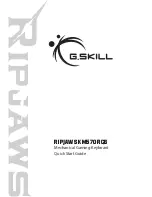Summary of Contents for Sk PRO
Page 1: ...REFERENCE GUIDE...
Page 2: ......
Page 4: ......
Page 5: ...TABLE OF CONTENTS...
Page 18: ...THIS PAGE INTENTIONALLY LEFT BLANK TO PRESERVE PAGE FORMATTING HA O SK PRO Reference Guide...
Page 19: ...INTRODUCTION...
Page 28: ...THIS PAGE INTENTIONALLY LEFT BLANK TO PRESERVE PAGE FORMATTING HA O SK PRO Reference Guide...
Page 29: ...INFORMATION CENTER DISPLAY...
Page 45: ...ALLOCATING VOICE SECTIONS...
Page 54: ...THIS PAGE INTENTIONALLY LEFT BLANK TO PRESERVE PAGE FORMATTING HA O SK PRO Reference Guide...
Page 55: ...COMBINATIONS PATCHES BUNDLES FAVORITES...
Page 137: ...ORGAN VOICE SECTION...
Page 200: ...THIS PAGE INTENTIONALLY LEFT BLANK TO PRESERVE PAGE FORMATTING HA O SK PRO Reference Guide...
Page 201: ...3PART ORGAN...
Page 209: ...UPPER PERCUSSION...
Page 215: ...PIANO ENSEMBLE VOICE SECTIONS...
Page 290: ...THIS PAGE INTENTIONALLY LEFT BLANK TO PRESERVE PAGE FORMATTING HA O SK PRO Reference Guide...
Page 291: ...MONO SYNTH VOICE SECTION...
Page 344: ...THIS PAGE INTENTIONALLY LEFT BLANK TO PRESERVE PAGE FORMATTING HA O SK PRO Reference Guide...
Page 345: ...CUSTOM SETS...
Page 396: ...THIS PAGE INTENTIONALLY LEFT BLANK TO PRESERVE PAGE FORMATTING HA O SK PRO Reference Guide...
Page 397: ...MULTI EFFECTS OVERDRIVE EQUALIZER...
Page 472: ...THIS PAGE INTENTIONALLY LEFT BLANK TO PRESERVE PAGE FORMATTING HA O SK PRO Reference Guide...
Page 473: ...SPECIAL PERFORMANCE FEATURES...
Page 504: ...THIS PAGE INTENTIONALLY LEFT BLANK TO PRESERVE PAGE FORMATTING HA O SK PRO Reference Guide...
Page 505: ...MIDI incl INT EXT ZONES...
Page 511: ...MIDI 493 MIDI Templates SK PRO HA O SK PRO Reference Guide...
Page 512: ...MIDI 494 MIDI Templates SK PRO HA O SK PRO Reference Guide...
Page 547: ...SPECIAL UTILITY FEATURES...
Page 567: ...Special Utility Features 549 t SYSTEM PARAMETER LIST HA O SK PRO Reference Guide...
Page 568: ...THIS PAGE INTENTIONALLY LEFT BLANK TO PRESERVE PAGE FORMATTING HA O SK PRO Reference Guide...
Page 569: ...USING MEMORY...
Page 591: ...APPENDIX...
Page 592: ...Appendix 574 APPENDIX u FACTORY COMBINATIONS HA O SK PRO Reference Guide...
Page 593: ...Appendix 575 u COMBINATION PARAMETERS HA O SK PRO Reference Guide...
Page 594: ...Appendix 576 HA O SK PRO Reference Guide...
Page 595: ...Appendix 577 u ORGAN PATCHES HA O SK PRO Reference Guide...
Page 596: ...Appendix 578 u ORGAN PATCH PARAMETERS HA O SK PRO Reference Guide...
Page 597: ...Appendix 579 HA O SK PRO Reference Guide...
Page 598: ...Appendix 580 u PIANO ENSEMBLE PATCHES HA O SK PRO Reference Guide...
Page 599: ...Appendix 581 HA O SK PRO Reference Guide...
Page 600: ...Appendix 582 HA O SK PRO Reference Guide...
Page 601: ...Appendix 583 u PIANO ENSEMBLE PATCH PARAMETERS HA O SK PRO Reference Guide...
Page 602: ...Appendix 584 HA O SK PRO Reference Guide...
Page 603: ...Appendix 585 u PIANO ENSEMBLE WAVEFORM LIST HA O SK PRO Reference Guide...
Page 604: ...Appendix 586 u MONO SYNTH PATCHES HA O SK PRO Reference Guide...
Page 605: ...Appendix 587 u MONO SYNTH PATCH PARAMETERS HA O SK PRO Reference Guide...
Page 606: ...Appendix 588 u PIPE ORGAN STOPS u ProChord VOICINGS HA O SK PRO Reference Guide...
Page 609: ...Appendix 591 u CUSTOM SETS HA O SK PRO Reference Guide...
Page 611: ...Appendix 593 u CUSTOM LESLIE PARAMETERS HA O SK PRO Reference Guide...
Page 612: ...Appendix 594 u SYSTEM PARAMETERS HA O SK PRO Reference Guide...
Page 613: ...Appendix 595 FAVORITES HA O SK PRO Reference Guide...
Page 614: ...Appendix 596 u MIDI TEMPLATES HA O SK PRO Reference Guide...
Page 615: ...Appendix 597 HA O SK PRO Reference Guide...
Page 616: ...Appendix 598 u MIDI INFORMATION HA O SK PRO Reference Guide...
Page 617: ...Appendix 599 u MIDI IMPLEMENTATION CHART HA O SK PRO Reference Guide...
Page 618: ...Appendix 600 u MIDI CHANNELS AND MESSAGES HA O SK PRO Reference Guide...
Page 622: ...Appendix 604 u DRAWBAR DATA LIST u SYSTEM EXCLUSIVE MESSAGES HA O SK PRO Reference Guide...
Page 624: ...2021 Hammond Suzuki USA Inc HA O SK PRO Reference Guide FM2330 1021...



































